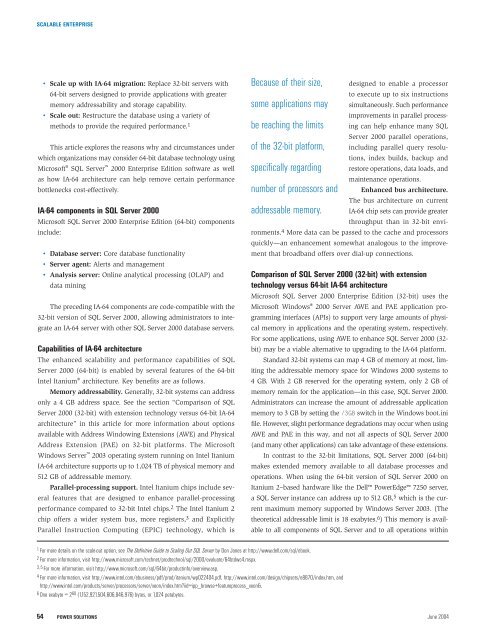Dell Power Solutions
Dell Power Solutions
Dell Power Solutions
- No tags were found...
You also want an ePaper? Increase the reach of your titles
YUMPU automatically turns print PDFs into web optimized ePapers that Google loves.
SCALABLE ENTERPRISE• Scale up with IA-64 migration: Replace 32-bit servers with64-bit servers designed to provide applications with greatermemory addressability and storage capability.• Scale out: Restructure the database using a variety ofmethods to provide the required performance. 1This article explores the reasons why and circumstances underwhich organizations may consider 64-bit database technology usingMicrosoft ® SQL Server 2000 Enterprise Edition software as wellas how IA-64 architecture can help remove certain performancebottlenecks cost-effectively.IA-64 components in SQL Server 2000Microsoft SQL Server 2000 Enterprise Edition (64-bit) componentsinclude:• Database server: Core database functionality• Server agent: Alerts and management• Analysis server: Online analytical processing (OLAP) anddata miningThe preceding IA-64 components are code-compatible with the32-bit version of SQL Server 2000, allowing administrators to integratean IA-64 server with other SQL Server 2000 database servers.Capabilities of IA-64 architectureThe enhanced scalability and performance capabilities of SQLServer 2000 (64-bit) is enabled by several features of the 64-bitIntel Itanium ® architecture. Key benefits are as follows.Memory addressability. Generally, 32-bit systems can addressonly a 4 GB address space. See the section “Comparison of SQLServer 2000 (32-bit) with extension technology versus 64-bit IA-64architecture” in this article for more information about optionsavailable with Address Windowing Extensions (AWE) and PhysicalAddress Extension (PAE) on 32-bit platforms. The MicrosoftWindows Server 2003 operating system running on Intel ItaniumIA-64 architecture supports up to 1,024 TB of physical memory and512 GB of addressable memory.Parallel-processing support. Intel Itanium chips include severalfeatures that are designed to enhance parallel-processingperformance compared to 32-bit Intel chips. 2 The Intel Itanium 2chip offers a wider system bus, more registers, 3 and ExplicitlyParallel Instruction Computing (EPIC) technology, which isBecause of their size,designed to enable a processorto execute up to six instructionssome applications may simultaneously. Such performanceimprovements in parallel processingcan help enhance many SQLbe reaching the limitsServer 2000 parallel operations,of the 32-bit platform, including parallel query resolutions,index builds, backup andspecifically regarding restore operations, data loads, andmaintenance operations.number of processors and Enhanced bus architecture.The bus architecture on currentaddressable memory. IA-64 chip sets can provide greaterthroughput than in 32-bit environments.4 More data can be passed to the cache and processorsquickly—an enhancement somewhat analogous to the improvementthat broadband offers over dial-up connections.Comparison of SQL Server 2000 (32-bit) with extensiontechnology versus 64-bit IA-64 architectureMicrosoft SQL Server 2000 Enterprise Edition (32-bit) uses theMicrosoft Windows ® 2000 Server AWE and PAE application programminginterfaces (APIs) to support very large amounts of physicalmemory in applications and the operating system, respectively.For some applications, using AWE to enhance SQL Server 2000 (32-bit) may be a viable alternative to upgrading to the IA-64 platform.Standard 32-bit systems can map 4 GB of memory at most, limitingthe addressable memory space for Windows 2000 systems to4 GB. With 2 GB reserved for the operating system, only 2 GB ofmemory remain for the application—in this case, SQL Server 2000.Administrators can increase the amount of addressable applicationmemory to 3 GB by setting the /3GB switch in the Windows boot.inifile. However, slight performance degradations may occur when usingAWE and PAE in this way, and not all aspects of SQL Server 2000(and many other applications) can take advantage of these extensions.In contrast to the 32-bit limitations, SQL Server 2000 (64-bit)makes extended memory available to all database processes andoperations. When using the 64-bit version of SQL Server 2000 onItanium 2–based hardware like the <strong>Dell</strong> <strong>Power</strong>Edge 7250 server,a SQL Server instance can address up to 512 GB, 5 which is the currentmaximum memory supported by Windows Server 2003. (Thetheoretical addressable limit is 18 exabytes. 6 ) This memory is availableto all components of SQL Server and to all operations within1 For more details on the scale-out option, see The Definitive Guide to Scaling Out SQL Server by Don Jones at http://www.dell.com/sql/ebook.2 For more information, visit http://www.microsoft.com/technet/prodtechnol/sql/2000/evaluate/64btdwc4.mspx.3, 5 For more information, visit http://www.microsoft.com/sql/64bit/productinfo/overview.asp.4 For more information, visit http://www.intel.com/ebusiness/pdf/prod/itanium/wp022404.pdf, http://www.intel.com/design/chipsets/e8870/index.htm, andhttp://www.intel.com/products/server/processors/server/xeon/index.htm?iid=ipp_browse+featureprocess_xeon&.6 One exabyte = 2 60 (1,152,921,504,606,846,976) bytes, or 1,024 petabytes.54POWER SOLUTIONS June 2004








